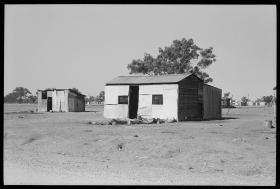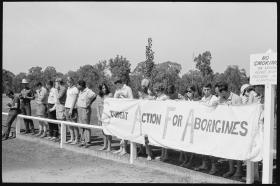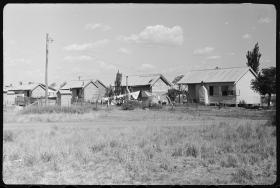Aboriginal rights and freedoms: the Freedom Ride
Using a range of primary sources, students investigate Aboriginal Australians’ rights and freedoms in first half of the twentieth century and the Freedom Ride that took place in NSW in February 1965.
Key inquiry question #1
How were Aboriginal and Torres Strait Islander people treated in Australia in the lead-up to the Freedom Ride in 1965?
Key inquiry question #2
How were the rights and freedoms of Aboriginal and Torres Strait Islander people affected by the Freedom Ride of 1965?
Learning intention
Students are learning to:
- Recognise the state of the rights and freedoms of Aboriginal and Torres Strait Islander people prior to 1965, and the role of the Freedom Ride at this time in history
- Interrogate sources in order to extract relevant information in response to historical inquiry
Success criteria
Students will be successful when they can:
- Outline defining characteristics of the background to the struggle of Aboriginal and Torres Strait Islander peoples for rights and freedoms before 1965
- Describe the impact of the Freedom Ride in the historical context of this event
Student Activities
Deconstructing the Freedom Ride
Students investigate a range of newspaper reports on events surrounding the Freedom Rides in order to better understand the event and its historical context.

Remembering the Freedom Ride
Using a range of collection materials, students imagine they are a member of SAFA and create a journal-style record of their experience on the Freedom Ride.

Comparing childhood experiences
Using collection items highlighted in previous activities, as well as their own research, students investigate and then compare and contrast the childhoods of Charlie Perkins and his daughter, Rachel.

NSW syllabus for the Australian Curriculum History K-10
HT5-3 Explains and analyses the motives and actions of past individuals and groups in the historical contexts that shaped the modern world and Australia
HT5-6 Uses relevant evidence from sources to support historical narratives, explanations and analyses of the modern world and Australia
Background to the struggle of Aboriginal and Torres Strait Islander peoples for rights and freedoms before 1965, including the 1938 Day of Mourning and the Stolen Generations (ACDSEH104)
Students:
- Outline the rights and freedoms denied to Aboriginal and Torres Strait Islander peoples before 1965 and the role and policies of the Aboriginal Protection Board, e.g. the control of wages and reserves
The US civil rights movement and its influence on Australia (ACDSEH105)
Students:
- Explain how the Freedom Rides in the US inspired civil rights campaigners in Australia
- Discuss the impact of the NSW Freedom Ride on the civil rights of Aboriginal and Torres Strait Islander peoples
Methods used by civil rights activists to achieve change for Aboriginal and Torres Strait Islander peoples, and the role of ONE individual or group in the struggle (ACDSEH134)
Students:
Investigate and explain the role of ONE individual or group in the struggle for Aboriginal and Torres Strait Islander peoples’ rights and freedoms
Analysis and use of sources
- process and synthesise information from a range of sources as evidence in an historical argument
Explanation and communication
- develop historical texts, particularly explanations and historical arguments that use evidence from a range of sources (ACHHS174, ACHHS188, ACHHS192)
- select and use a range of communication forms, such as oral, graphic, written and digital, to communicate effectively about the past for different audiences and different purposes (ACHHS175, ACHHS193)
Cause and effect: events, decisions and developments in the past that produce later actions, results or effects, eg the reasons for and impact of the struggle for rights and freedoms of Aboriginal and Torres Strait Islander peoples
Significance: the importance of an event, development, group or individual and their impact on their times and/or later periods
Learning across the curriculum
Cross-curriculum priorities
- Aboriginal and Torres Strait Islander histories and cultures
General capabilities
- Ethical understanding
- Information and communication technology capability
- Literacy
Other
- Civics and citizenship
Background notes for Teachers and Students
Background to status of Aboriginal Australians prior to 1965
Government policy around Aboriginal and Torres Strait Islander people in Australia went through several phases in the lead-up to the Freedom Ride of 1965.
When the Australian constitution took effect on 1 January 1901, each individual state acquired the primary lawmaking power over Aboriginal people. Consequently, the legal status of Aboriginal people shifted from British subjects to wards of the state. In each state, a Chief Protector was appointed. Their role was to administer the laws relating to Aboriginal people. This period of ‘protectionism’, which had begun in the late 1890s, would continue until the 1950s and was characterised by segregation. Colonial and State Aborigines Protection Acts were passed in each of the states, including the Aborigines Protection Act 1909 (NSW).
The Aborigines Protection Act would be the main piece of legislation governing the lives of Aboriginal people over the next 60 years in NSW. The Act vested power in the Aborigines Protection Board over all reserves in the State, enabling them to do such things as move Aboriginal people out of towns and into reserves or ‘missions’, install managers and other staff on these reserves, and block the movement of people in and out (including non-Aboriginal visitors). In later amendments, the Act allowed the Board to remove children of Aboriginal and non-Aboriginal parents from their homes and place them into homes where they would be raised ‘white’. This was one of the changes in policy that heralded the official start of a period of ‘enforced assimilation’ for ‘part-Aboriginals’. In 1940, the Aboriginal Welfare Board replaced the Aborigines Protection Board, and continued to work under the new policy direction of ‘assimilation’, closing reserves and encouraging people to move into the towns.
Policies of assimilation governed the lives of Aboriginal people from 1937 to the 1960s. In 1937 the Commonwealth Government held a conference on Aboriginal affairs, during which it was agreed that Aboriginal people ‘not of full blood’ be ‘assimilated’ into the community. Under these policies, Aboriginal people were expected to live like ‘white’ people, adopting European cultural practices and language and leaving their own culture and language behind. During this period, the rate of forced removal of Indigenous children from their families increased. In addition to the required rejection of their language and culture, a range of other rights and freedoms continued to be denied to Aboriginal people during this time including where they lived, whom they married, and how they spent their earnings. From the 1940s, Aboriginal people could apply for exemption from the Aboriginal Protection Act, whereby they would ‘cease to be Aboriginal’. Any person holding such a certificate of exemption had to live under certain rules, including living like a ‘white’ person, displaying exemplary behaviour, ceasing all contact with non-exempt Aborigines other than immediate family, and carrying their certificate with them at all times. In return, the certificate entitled them to such things as the freedom of movement, the right to drink alcohol and the right to own land.
It was within this context of institutionalised, widespread and historically ingrained discrimination that the Freedom Ride of 1965 took place.
Aboriginal-led resistance since 1770
The Aboriginal people of Australia had been leading resistance efforts, both within and outside European legal structures, since Cook’s arrival in 1770 at what would come to be known as Botany Bay. At this time, Joseph Banks recorded in his journal (Joseph Banks – Endeavour journal, 15 August 1769 – 12 July 1771) that the Gweagal people they encountered “resolvd to dispute our landing to the utmost tho they were but two and we 30 or 40 at least”. He went on to recount how, despite being initially startled by the Europeans firing a musquet over their heads, they quickly “renewd their threats and opposition”. This journal can be viewed in its entirety through the State Library of NSW’s catalogue or read the typed transcription. Banks’ recollections of the landing at Botany Bay begin on page 375.
Resistance efforts, led by Aboriginal people, continued from when the First Fleet landed in 1788, and often saw violent conflict break out as Aboriginal people took a stand against the occupation of their land and destruction of their communities and ways of life.
One of the most prominent resistance efforts within European legal structures, widely regarded to be the beginnings of contemporary Aboriginal political movement, was the 1938 Day of Mourning. On 26 January 1938, whilst most Australians were celebrating the sesquicentenary of European settlement, about 100 Aboriginal men, women and children from around Australia gathered at a venue on Elizabeth Street in Sydney, known as Australia Hall. In summarising the tone of the protest, organisers stated “the 26th of January, 1938 is not a day of rejoicing for Australia's Aborigines; it is a day of mourning. This festival of 150 years of so-called 'progress' in Australia commemorates also 150 years of misery and degradation imposed upon the original native inhabitants by the white invaders of this country.” The protestors intended to bring awareness of their plight to non-Indigenous Australians and have the Protection Boards dismantled, and rallied for full citizen rights for Aboriginal people. The event led to major reforms of the Protection Boards and contributed to bringing about the 1967 Referendum. The 1938 Day of Mourning is recognised as the first ever national Aboriginal civil rights gathering.
Pursuant to the Day of Mourning, the first edition of the newspaper The Australian Abo call: the voice of the Aborigines (the Abo Call) was published in April 1938. The Abo Call was in effect the Association’s monthly newsletter. Whilst it lasted for only six issues, owing to financial difficulties, the Abo Call is said to be the first Australian publication devoted to Aboriginal issues. Although the term ‘Abo’ is considered derogatory today, it was not always taken to be so and probably had a less pejorative connotation in 1938.
The Freedom Ride
In 1964 a group of students from the University of Sydney formed into a body called the Student Action for Aborigines (SAFA). The students’ attention had been drawn to issues of discrimination facing Aboriginal Australians after participating in protests in 1964 against racial segregation in the United States. After a period of planning and fund-raising, the students set off in February 1965 on a bus tour of regional New South Wales towns, inspired by the Freedom Rides that took place in the United States of America in 1961. Led by fellow student and Arrernte man Charles Perkins, SAFA had three key aims; to gather information in regards to the living conditions of the Aboriginal people in the communities they visited, protest against discrimination against Aboriginal people where they found it, and bring Aboriginal issues to the attention of mainstream consciousness by attracting a media spotlight to the experiences of Aboriginal people. SAFA also hoped to encourage and support Aboriginal people themselves to resist discrimination.
The Freedom Ride, as it came to be called, included visits to Walgett, Gulargambone, Kempsey, Bowraville and Moree. The students were shocked at the living conditions for Aboriginal people in these communities, and discovered they were routinely barred from clubs, swimming pools and cafes, and frequently refused service in shops and drinks in hotels. Demonstrating against racial discrimination at the Walgett Returned Services League, the Moree Baths, the Kempsey Baths and the Bowraville picture theatre, the students challenged practices of discrimination and ensured reports of their findings were shared through media channels across Australia. The evidence the students collected exposed endemic racism and added to the mounting pressure on government to address discrimination against Aboriginal Australians.
Additional material
From the collections of the State Library of NSW
- An article on “Changing Policies Towards Aboriginal People” from the Australian Law Reform Commission
- The book “Freedom Ride: A Freedom Rider Remembers” by Ann Curthoys, available as an eBook through the State Library of NSW (you will need a library card to access this electronic resource)
- A series of oral histories recorded by Faith Bandler, a member of SAFA who participated in the Freedom Ride, available through the State Library of NSW’s Amplify project.
External (to the collections of the State Library of NSW)
- A website from the City of Sydney council called Sydney Barani
- Right Wrongs, a website from the ABC